ACS6, a Hydrogen sulfide-donating derivative of sildenafil, inhibits homocysteine-induced apoptosis by preservation of mitochondrial function
- PMID: 22146536
- PMCID: PMC3231821
- DOI: 10.1186/2045-9912-1-20
ACS6, a Hydrogen sulfide-donating derivative of sildenafil, inhibits homocysteine-induced apoptosis by preservation of mitochondrial function
Abstract
Background: The hydrogen sulfide-releasing sildenafil, ACS6, has been demonstrated to inhibit superoxide formation through donating hydrogen sulfide (H2S). We have found that H2S antagonizes homocysteine-induced oxidative stress and neurotoxicity. The aim of the present study is to explore the protection of ACS6 against homocysteine-triggered cytotoxicity and apoptosis and the molecular mechanisms underlying in PC12 cells.
Methods: Cell viability was determined by Cell Counting Kit-8 assay. Cell apoptosis was observed using the chromatin dye Hoechst 33258 and analyzed by Flow Cytometry after propidium iodide staining. Mitochondrial membrane potential was monitored using the fluorescent dye Rh123. Intracellular reactive oxygen species were determined by oxidative conversion of cell permeable 2',7'-dichlorfluorescein-diacetate to fluorescent 2',7'-dichlorfluorescein. The expression of cleaved caspase-3 and bcl-2 and the accumulation of cytosolic cytochrome c were analyzed by Western blot.
Results: We show that ACS6 protects PC12 cells against cytotoxicity and apoptosis induced by homocysteine and blocks homocysteine-triggered cytochrome c release and caspase-3 activation. ACS6 treatment results in not only prevention of homocysteine-caused mitochondrial membrane potential (Δψ) loss and reactive oxygen species (ROS) overproduction but also reversal of Bcl-2 down-expression.
Conclusions: These results indicate that ACS6 protects PC12 cells against homocysteine-induced cytotoxicity and apoptosis by preservation of mitochondrial function though inhibiting both loss of Δψ and accumulation of ROS as well as modulating the expression of Bcl-2. Our study provides evidence both for a neuroprotective effect of ACS6 and for further evaluation of ACS6 as novel neuroprotectants for Alzheimer's disease associated with homocysteine.
Figures


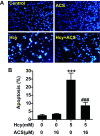
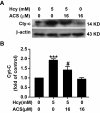
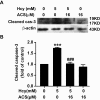
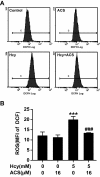
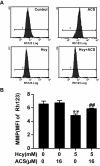
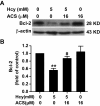
Similar articles
-
Role of paraoxonase-1 in the protection of hydrogen sulfide-donating sildenafil (ACS6) against homocysteine-induced neurotoxicity.J Mol Neurosci. 2013 May;50(1):70-7. doi: 10.1007/s12031-012-9862-x. Epub 2012 Jul 29. J Mol Neurosci. 2013. PMID: 22843253
-
Hydrogen sulfide antagonizes homocysteine-induced neurotoxicity in PC12 cells.Neurosci Res. 2010 Nov;68(3):241-9. doi: 10.1016/j.neures.2010.07.2039. Epub 2010 Jul 30. Neurosci Res. 2010. PMID: 20674619
-
Hydrogen sulfide inhibits MPP(+)-induced apoptosis in PC12 cells.Life Sci. 2009 Aug 12;85(7-8):269-75. doi: 10.1016/j.lfs.2009.05.023. Epub 2009 Jun 21. Life Sci. 2009. PMID: 19540852
-
Hydrogen sulfide prevents formaldehyde-induced neurotoxicity to PC12 cells by attenuation of mitochondrial dysfunction and pro-apoptotic potential.Neurochem Int. 2012 Jul;61(1):16-24. doi: 10.1016/j.neuint.2012.04.011. Epub 2012 Apr 20. Neurochem Int. 2012. PMID: 22542418
-
Hydrogen sulfide attenuates homocysteine-induced neurotoxicity by preventing mitochondrial dysfunctions and oxidative damage: In vitro and in vivo studies.Neurochem Int. 2018 Nov;120:87-98. doi: 10.1016/j.neuint.2018.07.010. Epub 2018 Jul 26. Neurochem Int. 2018. PMID: 30055195
Cited by
-
Caffeine Prevents Memory Impairment Induced by Hyperhomocysteinemia.J Mol Neurosci. 2018 Oct;66(2):222-228. doi: 10.1007/s12031-018-1158-3. Epub 2018 Aug 23. J Mol Neurosci. 2018. PMID: 30140995
-
Role of hydrogen sulfide in brain synaptic remodeling.Methods Enzymol. 2015;555:207-29. doi: 10.1016/bs.mie.2014.11.025. Epub 2015 Jan 13. Methods Enzymol. 2015. PMID: 25747482 Free PMC article. Review.
-
Hydrogen sulfide alleviates oxidative stress injury and reduces apoptosis induced by MPP+ in Parkinson's disease cell model.Mol Cell Biochem. 2020 Sep;472(1-2):231-240. doi: 10.1007/s11010-020-03801-y. Epub 2020 Jun 23. Mol Cell Biochem. 2020. PMID: 32577946
-
Pills of Multi-Target H2S Donating Molecules for Complex Diseases.Int J Mol Sci. 2024 Jun 27;25(13):7014. doi: 10.3390/ijms25137014. Int J Mol Sci. 2024. PMID: 39000122 Free PMC article. Review.
-
H2S biosynthesis and catabolism: new insights from molecular studies.Cell Mol Life Sci. 2017 Apr;74(8):1391-1412. doi: 10.1007/s00018-016-2406-8. Epub 2016 Nov 14. Cell Mol Life Sci. 2017. PMID: 27844098 Free PMC article. Review.
References
-
- Parsons RB, Waring RH, Ramsden DB, Williams AC. In vitro effect of the cysteine metabolites homocysteic acid, homocysteine and cysteic acid upon human neuronal cell lines. Neurotoxicology. 1998;19(4-5):599–603. - PubMed
LinkOut - more resources
Full Text Sources
Other Literature Sources
Research Materials

